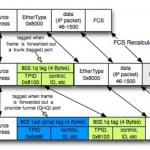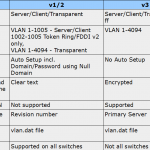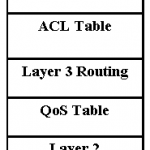The IP Helper address forwards a broadcast to a single specified IP. Before using the IP Helper command, you must first change the interface to prepare the router to relay broadcasts. The command is as follows: Switch# conf t Switch(config)#interface Fa0/1 Switch(config-if)#ip helper-address 192.168.1.254 Switch(config-if)#end Switch#wr mem This will configure the router to forward several …
Monthly Archive: February 2017
Feb 02
Trunking/VLAN tagging (802.1Q)
IEEE 802.1Q is the networking standard that supports virtual LANs (VLANs) on an Ethernet network. The standard defines a system of VLAN tagging for Ethernet frames and the accompanying procedures to be used by bridges and switches in handling such frames. 802.1Q frame tagging Configuration: Switch#configure terminal Enter configuration commands, one per line. End with CNTL/Z. Swith(config)#int …
Feb 02
VTP Pruning and manual pruning
VTP Pruning VTP pruning offers a dynamic mechanism that automatically configures the allowed VLAN lists on trunks within a VTP domain. Based upon whether or not a switch has ports currently active within a VLAN, the switch dynamically indicates to the remote switch on the other side of a trunk that the traffic within the …
Feb 01
VTP v1/v2/v3
VLAN Trunking Protocol (VTP) is a Cisco proprietary protocol that propagates the definition of Virtual Local Area Networks (VLAN) on the whole local area network. To do this, VTP carries VLAN information to all the switches in a VTP domain. Important to remember about VTP: By defaul switch out of the box is in a …
Feb 01
Troubleshoot Err-disable recovery
What is Err-disable? If the configuration shows a port to be enabled, but software on the switch detects an error situation on the port, the software shuts down that port. In other words, the port is automatically disabled by the switch operating system software because of an error condition that is encountered on the port. …
Feb 01
Managing MAC address table on Cisco Catalyst switch
There are two types of MAC tables on Cisco Catalyst switches CAM and TCAM. CAM is Layer 2 table used in all switches and TCAM is a layer 3 table therefore is utilized to routing and other network layer CAM stands for Content Addressable Memory which is a special type of memory used by Cisco …




